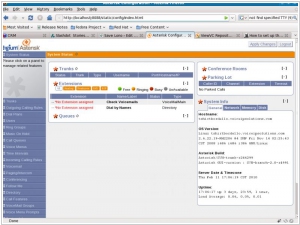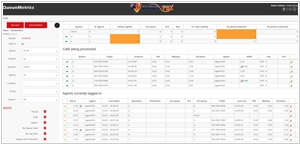Asterisk vs FusionPBX
July 29, 2023 | Author: Adam Levine
9

An open source telephony switching and private branch exchange service for Linux. Information on downloading, installation of and support for the product. Asterisk is like a box of Legos for people who want to create communications applications. It includes all the building blocks needed to create a PBX, an IVR system, a conference bridge and virtually any other communications app you can imagine.
9

FusionPBX can be used as a highly available single or domain based multi-tenant PBX, carrier grade switch, call center server, fax server, voip server, voicemail server, conference server, voice application server, appliance framework and more. FreeSWITCH™ is a highly scalable, multi-threaded, multi-platform communication platform.
Asterisk and FusionPBX are both popular open-source telephony platforms used for building and managing communication systems. However, they have some key differences that set them apart in terms of functionality and usability.
1. Core Functionality: Asterisk is primarily a telephony engine and toolkit that provides the foundation for building communication applications. It offers a wide range of features, including call routing, voicemail, conferencing, and support for various VoIP protocols. While it is powerful and flexible, setting up and configuring Asterisk typically requires more technical expertise. On the other hand, FusionPBX is a complete, user-friendly PBX (Private Branch Exchange) system built on top of Asterisk. It provides a web-based interface that simplifies the management and configuration of the Asterisk system, making it more accessible to users with less technical knowledge.
2. User Interface: As mentioned, Asterisk relies heavily on configuration files and a command-line interface for setup and administration. This can be challenging for those unfamiliar with the intricacies of Asterisk's configuration syntax. In contrast, FusionPBX offers a web-based GUI (Graphical User Interface) that streamlines the process of managing the telephony system. Administrators can easily configure extensions, trunks, IVRs (Interactive Voice Response), and other features through the user-friendly interface, making it more convenient for businesses and organizations seeking a ready-to-use PBX solution.
3. Customization and Extensibility: Asterisk is renowned for its extensive customization capabilities. It allows developers to create custom dial plans, applications, and integrations, making it suitable for complex and unique communication needs. However, this flexibility comes at the cost of complexity, and inexperienced users might find it overwhelming. FusionPBX, while offering a user-friendly interface, also allows for some customization and extension through its plugin system. Though it might not be as versatile as pure Asterisk, it strikes a balance between ease of use and customization options, catering to a broader audience looking for a more straightforward PBX solution.
See also: Top 10 Business Phone systems
1. Core Functionality: Asterisk is primarily a telephony engine and toolkit that provides the foundation for building communication applications. It offers a wide range of features, including call routing, voicemail, conferencing, and support for various VoIP protocols. While it is powerful and flexible, setting up and configuring Asterisk typically requires more technical expertise. On the other hand, FusionPBX is a complete, user-friendly PBX (Private Branch Exchange) system built on top of Asterisk. It provides a web-based interface that simplifies the management and configuration of the Asterisk system, making it more accessible to users with less technical knowledge.
2. User Interface: As mentioned, Asterisk relies heavily on configuration files and a command-line interface for setup and administration. This can be challenging for those unfamiliar with the intricacies of Asterisk's configuration syntax. In contrast, FusionPBX offers a web-based GUI (Graphical User Interface) that streamlines the process of managing the telephony system. Administrators can easily configure extensions, trunks, IVRs (Interactive Voice Response), and other features through the user-friendly interface, making it more convenient for businesses and organizations seeking a ready-to-use PBX solution.
3. Customization and Extensibility: Asterisk is renowned for its extensive customization capabilities. It allows developers to create custom dial plans, applications, and integrations, making it suitable for complex and unique communication needs. However, this flexibility comes at the cost of complexity, and inexperienced users might find it overwhelming. FusionPBX, while offering a user-friendly interface, also allows for some customization and extension through its plugin system. Though it might not be as versatile as pure Asterisk, it strikes a balance between ease of use and customization options, catering to a broader audience looking for a more straightforward PBX solution.
See also: Top 10 Business Phone systems


